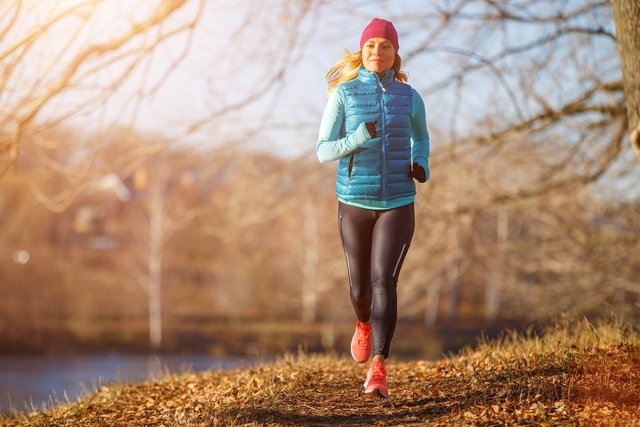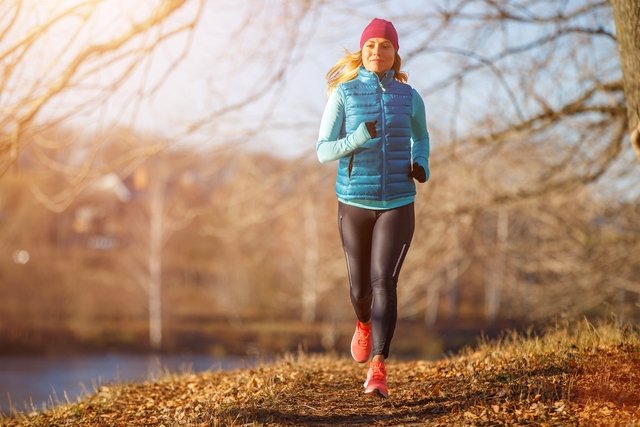Training in the cold has many benefits for the body, such as strengthening the immune system, reducing the risk of cardiovascular diseases, improving sleep quality and combating seasonal depression, for example
Furthermore, training in the cold causes greater energy expenditure to maintain body temperature balance and, therefore, can increase the number of calories burned during exercise, and promote weight loss.
Ideally, training during the cold should be done with the guidance of a physical educator and after having a health check-up with a general practitioner or cardiologist, especially for people who want to start physical activity. Furthermore, it is important to take some precautions to train safely, such as wearing clothing and sneakers suitable for the cold and keeping the body hydrated to avoid hypothermia.

9 benefits of training in the cold
In addition to helping you lose weight, training in winter also brings other health benefits such as:
1. Helps you burn more calories
Training in the cold helps you burn more calories, as the body needs to generate more heat to keep the organs and muscles warm, which can promote weight loss.
A study (1) showed that being or training outdoors in cold weather can transform white fat into brown fat, which in turn burns calories to generate energy and warm the body.
However, even if calorie expenditure is higher in winter, it is important that physical activity is also practiced in summer with the same regularity, as this makes it possible to maintain health and well-being, and control body weight.
2. Strengthens the immune system
Repeated and frequent exposure to cold, in addition to getting the body used to low temperatures, also helps to increase the activity of the immune system, which can reduce the risk of common illnesses, such as the flu or cold.
Furthermore, when training abroad, you should also avoid crowded places, such as gyms or sports centers, reducing the chances of catching a virus or bacteria.
3. Prevents cardiovascular diseases
When training in the cold, the heart needs to pump blood more quickly to heat the entire body, thus there is an increase in blood circulation that helps reduce blood pressure, high cholesterol and blood glucose levels, reducing the risk and preventing cardiovascular diseases, such as hypertension, stroke or heart attack.
4. Improves lung function
Breathing during training in the cold can be a little more difficult due to the difference in temperature, however, this change helps the body and lungs train to use oxygen more efficiently, improving performance during exercise and energy during exercise. the day by day.
5. Increases resistance
Training in the cold causes an increase in effort on the body, especially on the cardiovascular and respiratory systems. However, this increase in effort is good for increasing the body’s hardness and resistance, as long as it is not done in excess, creating too much wear and tear.
6. Helps fight seasonal depression
Training in the cold also helps combat seasonal depression, which is more common in colder seasons, such as autumn and winter, due to shorter days and less exposure to the sun, which results in hormonal changes and symptoms such as difficulty paying attention. , lack of hope, tiredness or social isolation, for example.
In this way, physical exercise in the cold helps regulate hormones and release endorphins, which improves mood and sleep regulation, and helps fight seasonal depression. Understand better what seasonal depression is and its symptoms.
7. Improves sleep quality
Training in the cold, in addition to improving your mood, helps you sleep better and improve sleep quality, as the cold stimulates the body’s parasympathetic system, which helps with relaxation.
Furthermore, training in the cold increases the production of endorphins, such as dopamine and serotonin, which help regulate the circadian cycle, responsible for regulating sleep and waking up.
8. Leaves skin and hair more beautiful
One of the most natural ways to keep your skin beautiful is to use cold water, as this helps to close the pores, preventing the appearance of blackheads and excessive oil. Training in a cold environment has the same effect as it helps to close your pores after training.
Furthermore, the cold also brings benefits to hair strands, as it helps to improve the health of hair follicles and increase their ability to stay on the scalp, preventing excessive hair loss.
9. Increases the production of vitamin D
During autumn or winter, vitamin D levels may be lower because the days are shorter and the person is less exposed to sunlight.
However, a good way to increase vitamin D is to train outside, during the day, when it is still bright and sunny. Understand the importance of vitamin D for the body.
To safely chirp in the cold, some precautions are important, such as:
- Warm up muscles before starting training and stretch after finishing training;
- Keep the body hydrated before, during and after training;
- Eat a pre-workout diet, rich in cardiothoracic and protein, to give the body energy and promote muscle growth and repair. See what to eat before training;
- Have a carbohydrate-rich snack during training to maintain energy, especially if training is intense or lasts more than 1 hour;
- Eat carbohydrates and proteins after training, to replenish the body’s glycogen stores, which are an energy reserve, and promote muscle recovery;
- Wear pants and an undershirt made of synthetic material, such as polypropylene or polyester, which absorb sweat from the body and prevent the person from becoming wet with sweat, which can cause or increase the feeling of cold;
- Wear sweatpants and a sweatshirt or fleece over a layer of synthetic clothing to keep your body warm;
- Wear socks and sneakers suitable for colder temperatures.
Furthermore, it is important to wear gloves, a hat or a face mask to protect the extremities of the body, as they are more vulnerable to the cold, as the body reserves energy for the organs and proper body functioning when in cold temperatures.
It is also important to apply body moisturizer to avoid dry skin and even frostbite.
How to increase calorie burning
Although training in the cold helps to burn some extra calories, this number is generally not enough to make a noticeable difference in the weight loss process.
Therefore, to enhance weight loss in the cold, it is important to help the body activate the burning of fat that helps keep the body warm. To do this, before starting your workout you can jump rope as fast as possible for 1 minute, rest for 30 seconds and repeat the previous two steps for 10 to 20 minutes.
This way, it is possible to warm up the muscles more quickly and increase the metabolic rate, leaving the body prepared for training.
Furthermore, it is recommended to avoid eating a diet with lots of fatty foods or lots of carbohydrates, which is more common in winter, as it helps the body have energy to warm up. See an example of a diet menu to lose weight quickly and healthily.
What are the best exercises in the cold?
The best exercises to obtain the benefits of training in the cold are walking, running, functional training or cycling, for example, which should preferably be done outdoors, taking every precaution to keep the body warm. and hydrated.
Risks of training in the cold
Although it has many benefits, training in the cold can also increase the risk of hypothermia, which happens when the body loses more heat than it can generate, and is normally caused by prolonged stay in very cold environments. Understand what hypothermia is.
Hypothermia is a serious condition, which can be perceived through symptoms such as purple or reddened skin, intense tremors, numbness or tingling in the arms and legs, slower and weaker breathing, loss of motor coordination or slurred speech.
If hypothermia is suspected, medical help should be sought immediately, taking the person to the nearest emergency room or calling SAMU on 192, as it is a medical emergency that can be life-threatening if not treated appropriately. quickly.

Sign up for our newsletter and stay up to date with exclusive news
that can transform your routine!
Warning: Undefined array key "title" in /home/storelat/public_html/wp-content/plugins/link-whisper-premium/templates/frontend/related-posts.php on line 12
Warning: Undefined array key "title_tag" in /home/storelat/public_html/wp-content/plugins/link-whisper-premium/templates/frontend/related-posts.php on line 13




